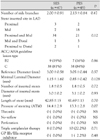1. Lee CH, Tan HC, Bee H, et al. Procedural success and 30-day outcomes between CYPHER™ and TAXUS™ stent implantation for the treatment of bifurcation lesions: a single-center experience. J Invasive Cardiol. 2006. 18:39–42.
2. Moses JW, Leon MB, Popma JJ, et al. Sirolimus-eluting stents versus standard stents in patients with stenosis in a native coronary artery. N Engl J Med. 2003. 349:1315–1323.
3. Stone GW, Ellis SG, Cox DA, et al. A polymer-based, paclitaxel-eluting stent in patients with coronary artery disease. N Engl J Med. 2004. 350:221–231.
4. Fischman DL, Savage MP, Leon MB, et al. Fate of lesion-related side branches after coronary artery stenting. J Am Coll Cardiol. 1993. 22:1641–1646.
5. Pan M, Medina A, Suarez de Lezo J, et al. Follow-up patency of side branches covered by intracoronary Palmaz-Schatz stent. Am Heart J. 1995. 129:436–440.
6. Iniguez A, Macaya C, Alfonso F, Goicolea J, Hernendez R, Zarco F. Early angiographic changes of side branches arising from a Palmaz-Schatz stented coronary segments: results and clinical implications. J Am Coll Cardiol. 1994. 23:911–915.
7. Aliabadi D, Tilli FV, Browers TR, et al. Incidence and angiographic predictors of side branches occlusion following high-pressure intracoronary stenting. Am J Cardiol. 1997. 80:994–997.
8. Bhargava B, Waksman R, Lansky AJ, Kornowski R, Mehran R, Leon MB. Clinical outcomes of compromised side branch (stent jail) after coronary stenting with the NIR stent. Catheter Cardiovasc Interv. 2001. 54:295–300.
9. Mazur W, Grinstead WC, Hakim AH, et al. Fate of side branches after intracoronary implantation of the Gianturco-Rubin flex-stent for acute or threatened closure after percutaneous transluminal coronary angioplasty. Am J Cardiol. 1994. 74:1207–1210.
10. Kim KH, Jeong MH, Kim NH, et al. Long-term clinical and angiographic outcomes of side branch occlusion after stenting. Korean Circ J. 1999. 29:473–480.
11. Jin QH, Gai LY, Liu HB, Yang TS, Du LS. The influence of coronary main vessel stenting on side branches. Zhonghua Xin Xue Guan Bing Za Zhi. 2005. 33:543–546.
12. Poerner TC, Kralev S, Voelker W, et al. Natural history of small and medium-sized side branches after coronary stents implantation. Am Heart J. 2002. 143:627–635.
13. Al Suwaidi J, Berger PB, Rihal CS, et al. Immediate and long-term outcome of intracoronary stent implantation for true bifurcation lesions. J Am Coll Cardiol. 2000. 35:929–936.
14. Yamashita T, Nishida T, Adamian MG, et al. Bifurcation lesions: two stents versus one stent: immediate and follow-up results. J Am Coll Cardiol. 2000. 35:1145–1151.
15. Choi SY, Tahk SJ, Kim HS, et al. Predictors of side branch occlusion immediately after coronary stenting: an intravascular ultrasound study. Korean Circ J. 2002. 32:655–665.






 PDF
PDF ePub
ePub Citation
Citation Print
Print




 XML Download
XML Download